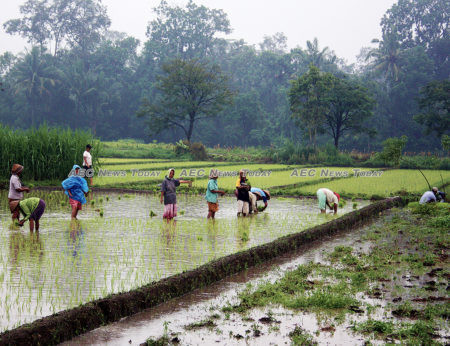In rural Indonesia rice accounts for almost one-quarter of the total expenditures of the poor. However, food prices have been on a rollercoaster ride because of unreliable production data, which for decades relied mainly on subjective measures of eye-estimate (relying on no device other than one’s own eyes to measure distances), creating unreliable evidence on which to base critical policy decisions.
In 2016 Indonesian President Joko Widodo responded by appointing the Central Bureau of Statistics (BPS) as the only agency responsible for collecting and releasing food production data.
Since then, BPS, along with the Agency for Assessment and Application of Technology (BPPT) and other agencies, has improved the calculation of the various stages of the rice production data collection.
Four major parameters and methodology were revised:
- revision of the total rice field area down from 7.75 million hectares (about 19.15 mln acres) in 2013 to 7.11 million (17.569 mln) in 2018;
- adoption of the Area Sampling Framework methodology to collect data on the vegetation phases of the sampled areas using an android-based application;
- land productivity, which is now sampled from the Area Sampling Framework areas only; and lastly
- the two conversion rates from dry threshed paddy to unhusked dry rice ready for milling, and from unhusked dry rice ready for milling to milled rice.
Two years later, in October 2018, vice president Jusuf Kalla acknowledged the newly revised rice production data, which was 30 per cent lower than previous estimates. The new data vindicated policymakers who tried to stabilise rice prices through imports.
The figures showed that there was only 2.85 million tonnes of rice surplus in 2018, compared to the previously claimed 10 million tonnes of rice surplus every year, 44 per cent of which had been thought held by producer-households, and 18 per cent by traders, etc; insufficient for the national buffer stock, especially in non-harvest months.
What does it mean for Indonesia?

Technology-based measurement should enhance transparency, accuracy, and accountability of rice production data that will assist policymakers and the private sector make better decisions concerning domestic supply to minimise rice price volatility and shocks.
Data collected monthly with GPS-enabled, geospatial-coordinate accuracy allows policymakers and the private sector to know precisely when and where rice is being harvested and the vegetative growth phases of rice production in each location.
Such statistical-geospatial data also enables the management of the regional distribution of rice, the forecasting of rice balance and import needs, as well as early mitigation of pest attack, flood, and drought.
In the medium and longer-term, more accurate data improves budget efficiency and farmers’ as well as consumers’ welfare through better production management and less volatile producer and consumer prices.
The take-away for other countries from Indonesia’s experience in improving food production data is that reform would not have been possible without political commitment at the highest level leading to across-the-board collaboration among key government agencies.
To a lesser extent, reform might not have been possible without the implicit agreement of “data amnesty”, so no one can be held accountable for any incorrect data in the past.
The idea is to be forward-looking and not looking back, with such philosophy critical for such a significant reform and which otherwise could have received a major backlash.

Although monumental, it is only the beginning.
The Indonesian government should apply this new methodology to other food commodities and continuously improve its food production data collection, taking advantage of the emerging availability of and accessibility to advanced technology, such as big data, machine learning, artificial intelligence, and the Internet of Things (IoT).
Most importantly, the new rice production data should be used in every possible way to improve policymaking decisions, improving budget efficiency, forecasting, and stock management.
This article was written by Maria Monica Wihardja & Mohamad Ikhsan It first appeared on World Bank Blogs under a Creative Commons License and is reproduced here with its permission.
Feature photo World Bank Blogs
Related:
- Rice remains a staple, but tastes changing (World-Grain )
- President Jokowi wants to make Indonesia self-sufficient in rice production (Global Indonesia Voice)
- Indonesia plans to export rice this year: Bulog chief (The Jakarta Post)
The World Bank Group consists of: The International Bank for Reconstruction and Development, The International Development Association, The International Finance Corporation, The Multilateral Investment Guarantee Agency, and The International Centre for Settlement of Investment Disputes.
By 2030 The World Bank aims to:
1. End extreme poverty by decreasing the percentage of people living on less than $1.25 a day to no more than 3%.
2. Promote shared prosperity by fostering the income growth of the bottom 40% for every country.
It aims to achieve this by providing low-interest loans, zero to low-interest credits, and grants to developing countries.
Latest posts by The World Bank (see all)
- Navigating COVID-19’s shock to the Malaysian economy – June 21, 2020
- Pilot study finds IoT AWD feasible for smallholder farmers in Vietnam – June 20, 2020
- Digital services in Vietnam thrive during pandemic, now for the next step (video) – May 31, 2020
- Improving Indonesia’s rice production through improved data collection – November 17, 2019


